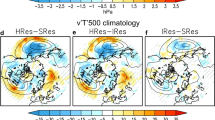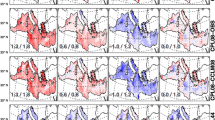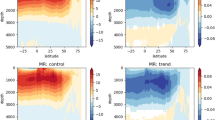Abstract
It has been hypothesized that the ocean mesoscale (particularly ocean fronts) can affect the strength and location of the overlying extratropical atmospheric storm track. In this paper, we examine whether resolving ocean fronts in global climate models indeed leads to significant improvement in the simulated storm track, defined using low level meridional wind. Two main sets of experiments are used: (i) global climate model Community Earth System Model version 1 with non-eddy-resolving standard resolution or with ocean eddy-resolving resolution, and (ii) the same but with the GFDL Climate Model version 2. In case (i), it is found that higher ocean resolution leads to a reduction of a very warm sea surface temperature (SST) bias at the east coasts of the U.S. and Japan seen in standard resolution models. This in turn leads to a reduction of storm track strength near the coastlines, by up to 20%, and a better location of the storm track maxima, over the western boundary currents as observed. In case (ii), the change in absolute SST bias in these regions is less notable, and there are modest (10% or less) increases in surface storm track, and smaller changes in the free troposphere. In contrast, in the southern Indian Ocean, case (ii) shows most sensitivity to ocean resolution, and this coincides with a larger change in mean SST as ocean resolution is changed. Where the ocean resolution does make a difference, it consistently brings the storm track closer in appearance to that seen in ERA-Interim Reanalysis data. Overall, for the range of ocean model resolutions used here (1° versus 0.1°) we find that the differences in SST gradient have a small effect on the storm track strength whilst changes in absolute SST between experiments can have a larger effect. The latter affects the land–sea contrast, air–sea stability, surface latent heat flux, and the boundary layer baroclinicity in such a way as to reduce storm track activity adjacent to the western boundary in the N. Hemisphere storm tracks, but strengthens the storm track over the southern Indian Ocean. A note of caution is that the results are sensitive to the choice of storm track metric. The results are contrasted with those from a high resolution coupled simulation where the SST is smoothed for the purposes of computing air–sea fluxes, an alternative method of testing sensitivity to SST gradients.

















Similar content being viewed by others
Notes
Strictly, we use the SST that is used to compute air–sea fluxes in the SmthSST case which by design is smoother than the actual ocean SST, see Sect. 2.
In our experiments transient eddy kinetic energy at 850 hPa shows very similar behavior to low level meridional wind variance in CESM.
References
Bishop SP, Bryan FO, Small RJ (2015) Bjerknes-like compensation in the wintertime North Pacific. J Phys Oceanogr 45:1339–1355
Booth JF, Thompson L, Patoux J, Kelly KA, Dickinson S (2010) The signature of midlatitude tropospheric storm tracks in the surface winds. J Clim 23:1160–1174
Booth JF, Thompson L, Patoux J, Kelly KA (2012) Sensitivity of midlatitude storm intensification to perturbations in the sea surface temperature near the Gulf Stream. Mon Weather Rev 140:1241–1256
Booth JF, Kwon Y-O, Ko S, Small RJ, Msadek R (2017) Spatial patterns and intensity of the surface storm tracks in CMIP5 models. J Clim 30:4965–4981
Brayshaw DJ, Hoskins B, Blackburn M (2009) The basic ingredients of the North Atlantic storm track. Part I: Land–sea contrast and orography. J Atmos Sci 66:2539–2558
Brayshaw DJ, Hoskins B, Blackburn M (2011) The basic ingredients of the North Atlantic storm track. Part II: Sea surface temperatures. J Atmos Sci 68:1784–1805
Bryan FO, Tomas R, Dennis JM, Chelton DB, Loeb NG, McClean JL (2010) Frontal scale air–sea interaction in high-resolution coupled climate models. J Clim 23:6277–6291
Businger S, Graziano TM, Kaplan ML, Rozumalski RA (2005) Cold-air cyclogenesis along the Gulf Stream front: investigation of diabatic impacts on cyclone development, frontal structure and track. Meteorol Atmos Phys 88:65–90
Catto JL, Jakob C, Berry G, Nicholls N (2012) Relating global precipitation to atmospheric fronts. Geophys Res Letts 39:L10805. https://doi.org/10.1029/2012GL051736
Chang EKM, Lee S, Swanson KL (2002) Storm track dynamics. J Clim 15:2163–2183
Colle BA, Zhang Z, Lombardo KA, Chang E, Liu P, Zhang M (2013) Historical evaluation and future prediction of eastern North American and Western Atlantic extratropical cyclones in the CMIP5 models during the cold season. J Clim 26:6882–6903
Czaja A, Blunt N (2011) A new mechanism for ocean–atmosphere coupling in midlatitudes. Q J R Meteorol Soc 137:1095–1101
Danabasoglu G, Bates SC, Briegleb BP, Jayne SR, Jochum M, Large WG, Peacock S, Yeager SG (2012) The CCSM4 ocean component. J Clim 25:1361–1389
Delworth TL et al (2006) GFDL’s CM2 global coupled climate models. Part I: formulation and simulation characteristics. J Clim 19:643–674
Delworth TL et al (2012) Simulated climate change in the GFDL CM2.5 high-resolution coupled climate model. J Clim 25:2755–2781
Dee DP, 35 co-authors (2011) The ERA-Interim reanalysis: configuration and performance of the data assimilation system. Q J R Meteorol Soc 137:553–597
Eady ET (1949) Long waves and cyclone waves. Tellus 1:33–52
Gent PR, McWilliams JC (1990) Isopycnal mixing in ocean circulation models. J Phys Oceanogr 20:150–155
Gent PR et al (2011) The community climate system model version 4. J Clim 24:4973–4991
Griffies SM et al (2014) Impacts on ocean heat from transient mesoscale eddies in a hierarchy of climate models. J Clim 28:952–977
Guo Y, Chang EKM, Leroy SS (2009) How strong are the southern hemisphere storm tracks? Geophys. Res Lett 36:L22806. https://doi.org/10.1029/2009GL040733
Hoskins BJ, Hodges KI (2002) New perspectives on the Northern hemisphere winter storm tracks. J Atmos Sci 59:1041–1061
Hoskins BJ, Hodges KI (2005) A new perspective on Southern hemisphere storm tracks. J Clim 18:4108–4129
Hoskins BJ, Valdes PJ (1990) On the existence of storm tracks. J Atmos Sci 47:1854–1864
Hunke EC, Lipscomb WH (2008) CICE: the Los Alamos sea ice model user’s manual, version 4. In: Los Alamos National Laboratory technical report LA-CC-06-012
Hurrell JW, and Coauthors (2013) The community Earth system model: a framework for collaborative research. Bull Am Meteorol Soc 94:1339–1360
Hurrell JW, Hack JJ, Shea D, Caron JM, Rosinski J (2008) A new sea surface temperature and sea ice boundary dataset for the community atmosphere model. J Clim 21:5145–5153
Joyce TM, Kwon Y-O, Yu L (2009) On the relationship between synoptic wintertime atmospheric variability and path shifts in the Gulf Stream and the Kuroshio extension. J Clim 22:3177–3192
Kuo Y-H, Reed RJ, Low-Nam S (1991) Effects of surface energy fluxes during the early development and rapid intensification stages of seven explosive cyclones in the western Atlantic. Mon Weather Rev 119:457–475
Kuwano-Yoshida A, Minobe S (2017) Storm-track response to SST fronts in the Northwestern Pacific in an AGCM. J Clim 30:1081–1102
Kuwano-Yoshida A, Minobe S, Xie S-P (2010) Precipitation response to the Gulf Stream in an atmospheric GCM. J Clim 23:3676–3698
Large WG, Yeager SG (2009) The global climatology of an interannually varying air–sea flux data set. Clim Dyn 33:341–364
Lawrence DM et al (2011) Parameterization improvements and functional and structural advances in version 4 of the community land model. J Adv Model Earth Syst 3:2011MS000045
Liu WT, Tang W (1996) Equivalent neutral wind. JPL Publication 96-17. http://www.ntrs.nasa.gov/archive/nasa/casi.ntrs.nasa.gov/19970010322.pdf
Liu JW, Zhang S-P, Xie S-P (2013) Two types of surface wind response to the East China Sea Kuroshio Front. J Clim 26:8616–8627
Lorenz DJ, Hartmann DL (2001) Eddy-zonal flow feedback in the Southern Hemisphere. J Atmos Sci 58:3312–3327
Ma X, co-authors (2016) Western boundary currents regulated by interaction between ocean eddies and the atmosphere. Nature 535:533–537
Ma X, Chang P, Saravanan R, Montuoro R, Hsieh J-S, Wu D, Lin X, Wu L (2015) Distant influence of Kuroshio eddies on North Pacific weather patterns. Sci Rep 5:17785 https://doi.org/10.1038/srep17785
Ma X, Chang P, Saravanan R, Montuoro R, Nakamura H, Wu D, Lin X, Wu L (2017) Importance of resolving Kuroshio Front and eddy influence in simulating the North Pacific storm track. J Clim 30:1861–1880
Minobe S, Kuwano-Yoshida A, Komori N, Xie S-P, Small RJ (2008) Influence of the Gulf Stream on the troposphere. Nature 452:206–209
Minobe S, Miyashita M, Kuwano-Yoshida A, Tokinaga H, Xie S-P (2010) Atmospheric response to the Gulf Stream: seasonal variations. J Clim 23:3699–3719
Nakamura M, Yamane S (2009) Dominant Anomaly Patterns in the Near-Surface Baroclinicity and Accompanying Anomalies in the Atmosphere and Oceans. Part I: North Atlantic Basin. J Clim 22:880–904
Nakamura H, Sampe T, Tanimoto Y, Shimpo A (2004) Observed associations among storm tracks, jet streams and midlatitude oceanic fronts. AGU Geophys Mono Ser 147:329–345
Nakamura H, Sampe T, Goto A, Ohfuchi W, Xie S-P (2008) On the importance of midlatitude frontal zones for the mean state and dominant variability in the tropospheric circulation. Geophys Res Lett 35:L15709. https://doi.org/10.1029/2008GL034010
Neu U et al (2013) IMILAST: a community effort to intercompare extratropical cyclone detection and tracking algorithms. Bull Am Meteorol Soc 94:529–547
O’Neill LW, Haack T, Chelton DB, Skyllingstad E (2017) The Gulf Stream convergence zone in the time-mean winds. J Clim 74:2383–2412
Ogawa F, Nakamura H, Nishii K, Miyasaka T, Kuwano-Yoshida A (2012) Dependence of the climatological axial latitudes of the tropospheric westerlies and storm tracks on the latitude of an extratropical oceanic front. Geophys Res Lett 39:2011GL049922
Parfitt R, Czaja A (2016) On the contribution of synoptic transients to the mean atmospheric state in the Gulf Stream region. Q J R Meteorol Soc 142:1554–1561
Park S, Bretherton CS, Rasch PJ (2014) Integrating cloud processes in the community atmosphere model, version 5. J Clim 27:6821–6856
Piazza M, Terray L, Boe J, Maisonnave E, Sanchez-Gomez E (2016) Influence of small-scale North Atlantic sea surface temperature patterns on the marine boundary layer and free troposphere: a study using the atmospheric ARPEGE model. Clim Dyn 46: 1699–1717
Putnam WM, Lin S-S (2007) Finite volume transport on various cubed sphere grids J. Comput Phys 227:55–78
Reynolds RW, Smith TM, Liu C, Chelton DB, Casey KS, Schlax MG (2007) Daily high-resolution-blended analyses for sea surface temperature. J Clim 20:5473–5496
Roberts MJ, Hewitt HT, Hyder P, Ferreira D, Josey SA, Mizielinski M, Shelly A (2016) Impact of ocean resolution on coupled air-sea fluxes and large-scale climate Geophys Res Lett 43:10430–10438. https://doi.org/10.1002/2016GL070559
Saba VS et al (2016) Enhanced warming of the Northwest Atlantic Ocean under climate change. J Geophys Res Ocean 121:118–132
Sheldon L, Czaja A, Vanniere B, Morcrette C, Sohet B, Casado M, Smith D (2017) A warm path to Gulf Stream–troposphere interactions. Tellus 69:1–13
Simpson IR, Bacmeister JT, Sandu I, Rodwell MJ (2018) Why do modelled and observed surface wind stress climatologies differ in the trade wind regions? J Clim 31:491–513
Small RJ, Tomas RA, Bryan FO (2014a) Storm track response to Ocean Fronts in a global high-resolution climate model. Clim Dyn 43:805–828
Small RJ et al (2014b) A new synoptic scale resolving global climate simulation using the community earth system model. J Adv Model Earth Syst 6:1065–1094. https://doi.org/10.1002/2014MS000363
Smirnov D, Newman M, Alexander MA, Kwon Y-O, Frankignoul C (2015) Investigating the local atmospheric response to a realistic shift in the Oyashio Sea surface temperature front. J Clim 28:1126–1147
Smith RD et al (2010), The parallel ocean program (POP) reference manual. In: Los Alamos National Laboratory technical report LAUR-10-01853
Stoelinga MT (1996) A potential vorticity-based study of the role of diabatic heating and friction in a numerically simulated baroclinic cyclone. Mon Weather Rev 124:849–874
Taguchi B, Nakamura H, Nonaka M, Xie S-P (2009) Influences of the Kuroshio/Oyashio extensions on air-sea heat exchanges and storm track activity as revealed in regional atmospheric model simulations for the 2003/04 cold season. J Clim 22:6536–6560
Trenberth KE (1991) Storm tracks in the southern hemisphere. J Atmos Sci 48:2159–2178
Vecchi GA et al (2014) On the seasonal forecasting of regional Tropical Cyclone activity. J Clim 27: 7994–8016
Ullrich PA, Zarzycki CM (2017) TempestExtremes: a framework for scale-insensitive pointwise feature tracking on unstructured grids. Geosci Model Dev 10:1069–1090
Wallace JM, Lim G-H, Blackmon ML (1988) Relationship between cyclone tracks, anticyclone tracks and baroclinic waveguides. J Atmos Sci 45:439–462
Wang CL, Zhang S-K, Lee L, Wu, Mechoso CR (2014) A global perspective on CMIP5 climate model biases. Nat Clim Change 4:201–205
Weese SR, Bryan FO (2006) Climate impacts of systematic errors in the simulation of the path of the North Atlantic current. Geophys Res Lett 33:L19708. https://doi.org/10.1029/2006GL027669
Weijer W, and co-authors (2012) The Southern Ocean and its climate in CCSM4. J Clim 25:2652–2675
Willison J, Robinson WA, Lackmann GM (2013) The importance of resolving mesoscale latent heating in the North Atlantic storm track. J Atmos Sci 70:2234–2250
Woollings T, Hoskins B, Blackburn M, Hassell D, Hodges K (2010) Storm track sensitivity to sea surface temperature resolution in a regional atmosphere model. Clim Dyn 35:341–353
Acknowledgements
An anonymous reviewer is thanked for constructive comments on the paper, especially for suggesting a more detailed assessment against ERA-Interim Reanalysis. CESM1 was a community development effort, as described in Hurrell et al. (2013), for which we are very grateful. The CESM1 simulations described in this paper were performed at NCAR Wyoming Supercomputer Center. We also thank Tom Delworth, Gabriel Vecchi and all the scientists at GFDL who invested time and resources to produce the GFDL CM simulations used in this research. RJS was supported by Department of Energy Office of Biological and Environmental Research, via the Scientific Discovery through Advanced Computing (SCIDAC) project number SC0006743,and National Science Foundation (NSF) Collaborative Research: EaSM-3: Regional decadal predictions of coupled climate-human systems 1419585. Y-OK was supported by NSF Division of Atmospheric and Geospace Science Climate and Large-scale Dynamics Program (AGS-1355339), NASA Physical Oceanography Program (NNX13AM59G), and DOE Office of Biological and Environmental Research Regional and Global Climate Modeling Program (DE-SC0014433). JFB was partially supported by the National Oceanic and Atmospheric Administration (NOAA) Climate Program Office’s Modeling, Analysis, Predictions, and Projections program, Grant #NA15OAR4310094. R. Msadek was supported by GFDL and UCAR when the GFDL simulations used in this paper were produced and analyzed. We thank Steve Griffies for helping interpreting the results. Discussions with Hisashi Nakamura, Niklas Schneider and Shoshiro Minobe were very appreciated.
Author information
Authors and Affiliations
Corresponding author
Electronic supplementary material
Below is the link to the electronic supplementary material.
Rights and permissions
About this article
Cite this article
Small, R.J., Msadek, R., Kwon, YO. et al. Atmosphere surface storm track response to resolved ocean mesoscale in two sets of global climate model experiments. Clim Dyn 52, 2067–2089 (2019). https://doi.org/10.1007/s00382-018-4237-9
Received:
Accepted:
Published:
Issue Date:
DOI: https://doi.org/10.1007/s00382-018-4237-9




